The Mcuzone MPS2280 M.2 NVMe HAT is another PCIe to NVMe adapter board built for the Raspberry Pi 5. What sets it apart from other boards is that it supports 2280 SSDs and offers the option to Jerry-rigg a 22110 SSD with zip ties.
Previously we have covered many PCIe to NVMe expansion boards such as Pimoroni NVMe Base, Geekworm X1003 PCIe to NVMe SSD adapter, and PineBerry Pi’s HatDrive, so feel free to check those out if interested.
Mcuzone MPS2280 M.2 NVMe HAT specifications:
- PCIe Support – Compatible with PCIe x1 interface, offering Gen2 and Gen3 modes.
- SSD compatibility – Supports M.2 M-key interface with 2280, 2242, and 2230 size SSDs, and offers the option to Jerry-rigg a 22110 SSD with zip ties.
- SSD booting – Enables booting from an NVMe SSD, with options for storage expansion. Alternatively, the system can boot from TF while using the SSD for storage.
- GPIO compatibility – Features 4x M2.5 fixing holes and a concave design for easy access to the Raspberry Pi 5’s 40Pin GPIO.
- Bandwidth capacity – Offers a theoretical bandwidth of 5Gbps in PCIe Gen2 mode and 8Gbps in PCIe Gen3 mode
- Indicators – Includes a power indicator (“PWR”) and an M.2 activation indicator (“ACT”).
- M.2 power supply – Features a 2A current design, but is limited to 5V/1A as per the Pi 5’s PCIe interface limit. The special version includes auxiliary power of 5V/3A.
- Quality – Utilizes high-quality electronic components and immersion gold technology, to produce a lead-free design.
- Dimensions – 85mm x 56mm.
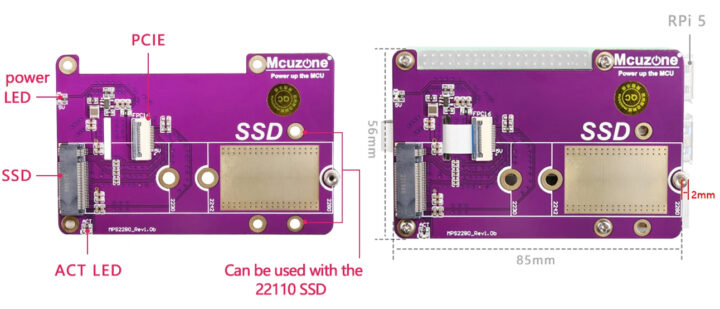
The design of this adapter is unique because it’s easy to access the 40-pin GPIO header of the Raspberry Pi 5 even when the hat is connected on top of the SSD.
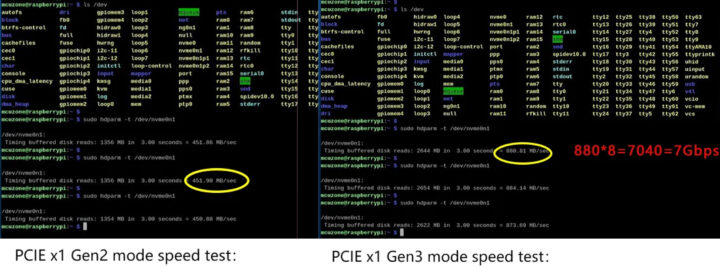
The company tested the SSD speeds and found that for Gen2, the read speed was 451.90 MB/s, while for Gen3 SSDs, it was faster at 880.81 MB/s.
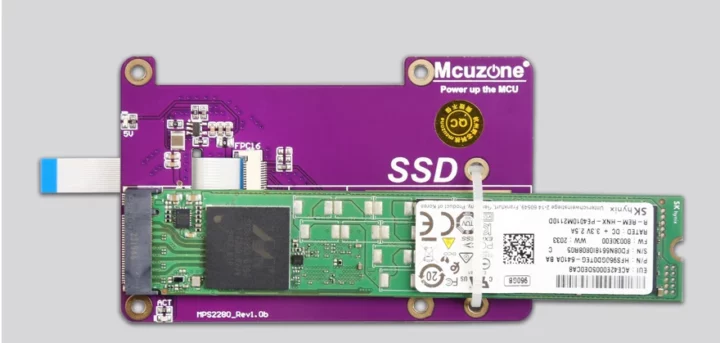
Funnily Mcuzone showcased that it’s also possible to connect a 22110 SSD to the Raspberry Pi 5 through this board with the help of a zip tie and two holes in the board
You can buy the Mcuzone MPS2280 PCIe to NVME board for Raspberry Pi 5 on AliExpress for $6.99 and up. The AliExpress product page also gives information about extra accessories that are available for purchase with the HAT and most people will likely want the $8.99 kit with FPC cable, standoffs, and screws.
Debashis Das is a technical content writer and embedded engineer with over five years of experience in the industry. With expertise in Embedded C, PCB Design, and SEO optimization, he effectively blends difficult technical topics with clear communication
Support CNX Software! Donate via cryptocurrencies, become a Patron on Patreon, or purchase goods on Amazon or Aliexpress


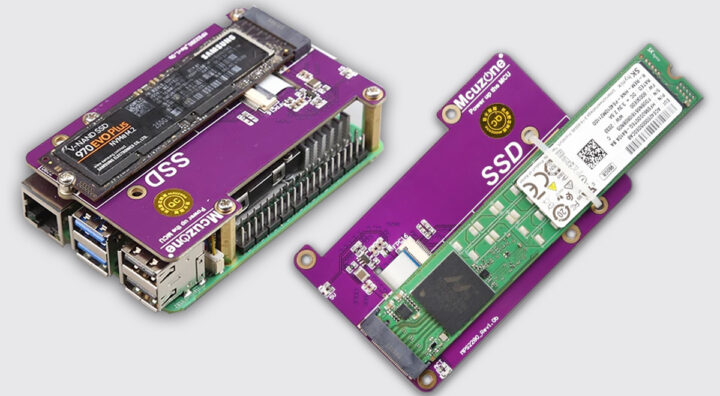
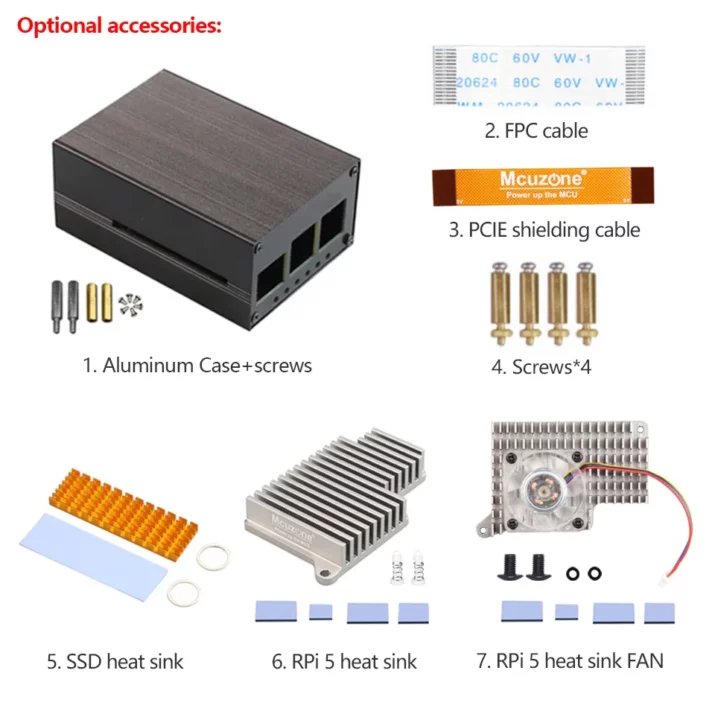
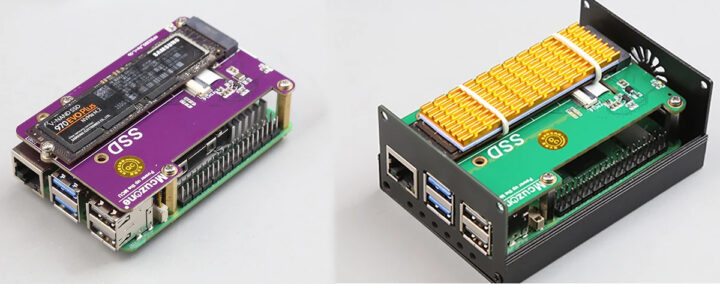



If after all these M.2 solutions, RPi continues not to understand that users are really bored by SD and USB as the only storage options by default, we won’t be able to do anything else to help them understand anything! Who know, maybe RPi6 will have a more suitable form factor and an M.2 connector, or even the same form factor and an M.2 connector underneath for a 2242, with an optional FPC extension to feed a larger one on top… Oh, and the idea that the hats should block the airflow was really a great one. In the end you choose between cooling and storage. That’s a bit annoying.
I’ll give them the same advice I give all other board makers:
I think there’s more, but this is all I can think of off of the top of my head. I’m sure Thomas will be along to correct any shortcomings of my list. 🙂
I’ve seen Micro-HDMI pop up in more places lately, like a portable display I was looking at.
> Flexible power input (barrel jack that takes up to 19V or USB-C *with* PD)
On their forums moderators insisted on barrel jacks being too dangerous since power bricks with 12V and above use same diameters and RPi users would fry their boards. So Micro-USB is the only possible option (me being banned back then the 2nd time in these ‘discussions’ and after the 3rd ban I lost interest dealing with Raspberry Pi Ltd. employees deleting my posts as such no ‘discussions’ about USB-C later).
As for their current PSU: this thing is a proper 27W power brick (negotiates 15V at 1.8A with my laptops) but they claim the RPi5 only negotiating 5V/5A would be more efficient compared to 9/12/15V. Claimed by the same entity that lets their board consume 1.8W in ‘powered off’ state due to some obscure ‘HAT drama’.
And BTW: they’re not able to understand the basic principles of DFVS and everyone eager for lower consumption figures with RPi 5 by tweaking config.txt ends up with a device consuming more. Pathetic as expected.
Yeah I generally agree with your points as well. And yes, the barrel jack with a wide voltage input is great. We’ve had this with PCEngines (7-20V) and the clearfog (9-20V IIRC) and that’s really cool, you pick whatever power brick you have and you know it will work. And it does.
Why long SSDs not designed to have hole in the middle?
Because it would take up too much space and make signal routing hell.
This is my first time ever seeing a 110mm M.2 drive. I thought they were just ‘allowed’ by the spec and that no one had actually made one. Why? Considering how much you can pack on a 2242, what do you need all that board area for? That’s just under a 1T drive shown. It’s got a ton of area for caps, but they aren’t populated. That’s just wasted board space.
I believe 2210 is mostly a thing of the past when high capacity ‘datacenter SSDs’ used this format. But this market segment mostly moved on to E1.S and U.2/U.3 in the meantime…
Caps on these datacenter SSDs are/were there for sudden power loss resiliency and maybe on this rather old SSD pictured above they were simply not soldered since this is an OEM model w/o power protection?
Thanks for the perspective.
I believe M.2 22110 SSDs are mostly for enterprise and found on ATX and larger motherboards. I see 4(!) of them on the ASUS Prime X670E-PRO WiFi Socket AM5 (LGA 1718) Ryzen 7000 ATX Motherboard, and I expect most Threadripper or E-ATX boards would have it.
They are on Newegg. Pricing is typically high, but I see a refurbished “MZ-1LW9600 Samsung PM963 960GB PCI-e 3.0 x4 NVMe M.2 22110 SSD MZ1LW960HMJP” for $62.
There has been talk of adopting wider M.2 2580 and M.2 25110 for consumer PCIe 5.0 SSDs, since it would have better heat dissipation. There are already consumer motherboards shipping that support this, but I’m not sure the SSDs exist yet:
tomshardware.com/news/pcie-5-ssds-may-get-fatter-require-wider-m2-slots
bhphotovideo.com/c/product/1766367-REG/gigabyte_b650m_k_am5_lga.html/specs
For single board computers, I can’t imagine caring about anything larger than M.2 2280 for the foreseeable future. And the 22110 drive just sticks out of this HAT. Supported, but not protected.
I think 2280 tends to cost less and have superior performance and endurance than 2230/2242 SSDs, by being less cramped and using more/cheaper chips, but I’m not sure. Capacity benefits are obvious, we could see 16 TB in M.2 2280 within a couple of years:
tomshardware.com/pc-components/storage/samsungs-upcoming-280-layer-qlc-flash-could-allow-for-16tb-m2-ssds-claims-up-to-50-higher-storage-density-than-the-competition
I pretty much assumed it was more of a legacy size from the early days of M.2 when they weren’t sure quite the use case and how integrated memory controllers and flash dies was going to get. So only seeing old drives in that size makes sense. It does surprise me to see a modern board going out of the way to support that size, but, if it’s just a matter of “don’t put anything here except a mounting hole”, it’s not that much to ask–but multi-layer boards are expensive and ever square cm counts. Interesting tradeoff there.
25mm wide? That’s not much over 22mm. I wonder why they don’t just go up to the already standard 30mm. That’s more area if you’re worried about heat dissipation.
Thanks for all of the link and for sharing your insight.
one benefit of the current 22mm is that many boards have enough space to fit two of them. At 30mm, much less boards will be able to do that. At 25, I don’t know.
I noticed that some 2280 just use the exact same chips as 2242 and are simply sold in this form factor to make it easier for end user to install them in their products. For example PC motherboards are generally configured by default with the screw at position 80, not 42, and to move it, you need to access the other side, quite annoying! I bought two “kingspec 250GB” on aliexpress, one in 2242 and one in 2280 and they were indeed exactly the same with same references, same performance etc (and pretty decent one for those interested in such cheap devices, around 2GB/s read).
> “kingspec 250GB”
And if you check SMART attributes do both report a constant temperature of 40°C and ‘wear-out’ of 0%?
Oh I wouldn’t be surprised at all, I hadn’t checked. I tried out of curiosity, at $16 or so, it was OK. It’s only to store LLMs so even if I lost them after one week it would not be an issue. I’m seeing that as an extremely fast USB stick you see 🙂
I just received this SSD board (burgundy colour) yesterday and similarly like with Rpi 4 and SSD in USB3.0 enclosure it failed to boot even dc3dd raw copy finished without any issue. Activity green led was flashing and solid green was solid but my screen remained empty.
It failed with Samsung PM981 NVMe. Then I did check on sticker and unfortunatelly I found 3.3V 2.8A power requirement. On Rpi4 it was replaced with SSD INTEL M2.80 512GB SATA SSD P/N 0X8V6H. And it was one week since runing 24/7 and with cpu on 100% due to (wanted) background processes btrfs scrub of few hundreds GB finished OK. I picked this drive for 3.3V 1.0A power requirement second hand on Ebay and it was actually cheaper than next SSD which I am waiting for. It is SSD Toshiba KXG60ZNV512G NVMe 512GB which should have also lesser power requirements and will be tested with SSD board in this review by end of this week.
KXG60ZNV512G NVMe 512GB arrived today and sucessfully runs on this hat and rpi5.
However before system was transfered from microSD to this SSD I could not see any other drive than boot drive. What was quite strange because this is what was not issue with Samsung PM981.
After some research SSD started being visible when added to config.txt next lines
dtparam=nvme
dtparam=pciex1_gen=3
I tried to (btrfs) scrub about 100GB of data with average speed of 844.76MiB/s without issue on Rpi5@2.9GHz. Good result. Missing at least 2500M network port but for most people good 64GB microSD card will be all-right and cheaper option